
Ventura County, once a Southern California stop-for-gas locale between Los Angeles and Santa Barbara, now has a great reason to stop and stay awhile - a wine trail of their own. The Ventura County Wine Trail is made up of 11 wineries calling Ventura County home plus four located in Malibu.
The area is a little too spread out to make for a convenient one-day excursion, but you can break it up into smaller segments and manage it a bit at a time.
The Malibu Section
Four wineries are in the Malibu and Malibu Hills area, up in the Santa Monica Mountains. Elevations of around 1,400 feet and cool ocean breezes make for some good grape-growing conditions.
Rosenthal Malibu Estate
In 1987 George Rosenthal planted the first grapes in this area since Prohibition and spearheaded the effort to get AVA status for Newton Canyon, which is contained in California's South Coast AVA. The winery's tasting room is actually down at sea level, on Pacific Coast Highway, with a great view of the beach.
Cornell Winery and Tasting Room
Cornell has its own wine to pour, but Tim Skogstrom also pours the wine of nearly two dozen other vintners in the Malibu Hills. It's a laid-back, history-laden place.
Cielo Malibu Estate Wineyards
Richard and Diana Hirsh founded Cielo in what was to become the Saddlerock Malibu AVA. Their '06 Syrah Blackcrow Mountain was a double gold award winner at the San Francisco International Wine Competition. The Cielo wines may be sampled at the SIP Malibu Tasting Room in Agoura.
Malibu Wines
Way up in the mountains right between the 101 Freeway and Pacific Coast Highway, Malibu Wines has two labels to offer. Semler is their estate label and Saddlerock is wine produced from grapes sourced elsewhere in the Central Coast.
The 101 Freeway Section
Four Brix Winery
Gary Stewart and the Four Brix Family source eleven different varities of grapes from nine vineyards in six appellations. Taste their wines at The Wineyard, home of their official tasting room in Thousand Oaks.
Los Robles Hills Winery
Also in Thousand Oaks, the Los Robles Hill vineyard is named Puerta del Cielo, which means "Gate of Heaven." It's an homage to the Spanish missionaries who traveled El Camino Real and planted a lot of grapes themselves.
Camarillo Custom Crush Winery
This a place where other vintners come to make their wines. The tasting room - open on weekends - features the wine of three local vineyards per week.
Bella Victorian Vineyard
A Victorian-style home with a vineyard in the backyard - it's a refreshing break from Southern California suburbia. The tasting room features a bistro, and the grounds are offered as a beautiful place for weddings.
Cantara Cellars
Cantara sources Northern California grapes from Lodi and pours their wines at the winery's tasting room in Camarillo.
Herzog Wine Cellars
Driven from their Slovakian home in 1948, the Herzog family moved to New York City, where they made wine until moving to California in 1985. Their winery was constructed some 20 years later in Oxnard. The tasting room is on-site, where you can try the Baron Herzog and Herzog Wine Cellars labels.
Magnavino Cellars
This Oxnard winery relies primarily on Lodi grapes. Their Viognier is sourced in Santa Barbara County.
Rancho Ventavo Cellars
Operating from an Oxnard avocado and lemon ranch, winemaker George Gilpatrick draws fruit from a variety of locales, including Paso Robles, Santa Barbara County and the Sierra Foothills. The tasting room is in downtown Oxnard.
The Ojai Section
Old Creek Ranch Winery
Wine production on the Old Creek Ranch in the Ojai Valley dates back to the 1800s. The original winery is still on the property, but the current version was founded in 1981. Old Creek Ranch is cattle ranch with fruit orchards, so the grapes are sourced from Napa Valley and a number of notable vineyards in Santa Barbara County. The tasting room overlooks the orchards. Feel free to bring a picnic lunch.
Casa Barranca
The Casa Barranca Estate is a national historic landmark featuring the 1909 California Craftsman Pratt House. The estate is unfortunately not open to the public, but the tasting room in downtown Ojai is. Their ICO certified organic vineyard produces Syrah, Grenache, Semillon and Viognier grapes.
Ojai Vineyard
Adam Tolmach produces excellent wines using grapes from Santa Barbara County - including the Sta. Rita Hills - and the Ojai Valley. The tasting room is located in downtown Ojai.
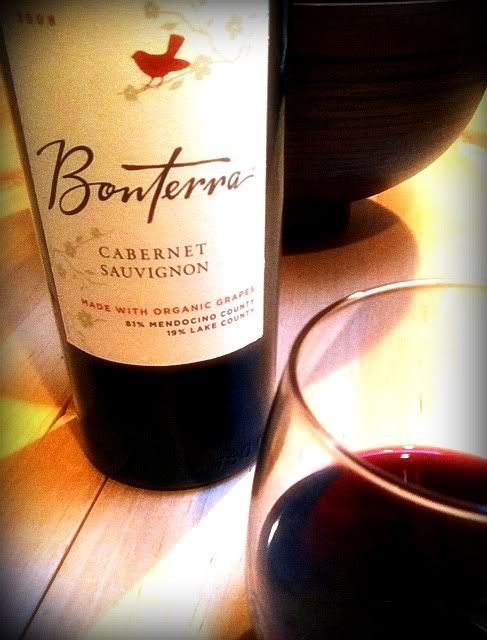
One of the nice things about being someone who is visibly interested in wine is the fact that friends and family never have to think too hard about what to give me on gift-giving occasions. Hint: it's a one-word answer.
My birthday triggered a very nice influx of bottles, so the wine rack at chez Now And Zin is full and happy. The first cork to pop from the birthday bounty was a very nice California Cabernet Sauvignon from Mendocino County.
Bonterra Winery is in Hopland, California. They farm organically, and have done so since 1987. All the fruit used in making this wine is organic; 81% of it comes from Mendocino County with 19% contributed by Lake County.
Winemaker Robert Blue states on the label his affinity for organic farming and his belief that it produces the highest quality grapes. Bonterra Winery and their grapes are certified by the California Certified Organic Farmers. That label on the bottle is even made from 100% post-consumer recycled product.
The Bonterra Cab carries a 13.5% abv number.
The Cabernet Sauvignon is blended with Merlot, Syrah and what Bonterra calls "other complementary varietals." I don’t know why they are so secretive about it, though. The wine is a medium-dark ruby color in the glass, and it offers a huge fruit expression on the nose. Cherries make the big play, with plenty of spiciness. I pick up the scent of white pepper and a layer of vanilla and cedar.
The alcohol shows too much in the first sip, about 15 minutes after the bottle was opened. Cherries, cherry cola and a raspberry note struggle to come forward through the haze.
Give it some time, and it settles down nicely. Eventually it becomes as smooth as silk. Over time, brambly notes and some graphite show up to augment the plum and blackberry flavors. Firm tannins are present even on the third night the bottle is open, and the black cherry cola finish stays a long time.
Bonterra has crafted a delicious wine that's downright affordable to buy - or to give as a gift.

There's another report citing health benefits of drinking wine. Wine Spectator magazine reports the results of a study conducted in southern and central Italy, in which it appears a lifetime of drinking red wine reduces the risk of developing essential tremor.
Essential tremor is the name for the uncontrollable shaking developed by some elderly people, which may be associated with Parkinson's disease.
The study shows that drinking four or five glasses of red wine per day for 30 years or so reduces the risk of tremors by 85%. Those who consumed three glasses a day over that same time frame showed a 65% lower risk.
While the study credits the antioxidants in red wine for the protection, it cautions that the results are not definitive. The sample was only 200 people, and 22 of them did develop essential tremor during the study. 19 of those fit the profile of the low-risk category.
The article quotes the authors of the study, "Case-control studies are generally prone to several kinds of bias. Larger ad-hoc studies are still needed to assess the role of alcohol drinking as a protective factor for developing essential tremor."
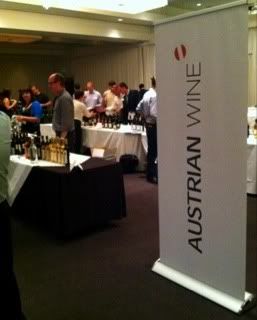
Austria Uncorked, a showing of Austrian wines at the SLS Hotel at Beverly Hills May 2nd, 2011, promised a bevy of fabulous white wines to sample - after all, highly structured whites are what Austria is best known for worldwide.
If Austria has a national grape, it would have to be Grüner Veltliner. The food-friendly, mineral-driven GruVee was all over the room at this event, with most tables pouring several versions. Riesling was popular, too. Chardonnay and Sauvignon Blanc also popped up from time to time. Riesling has a reputation as a sweet wine for some, but the Austrian expression of the grape is quite dry and sometimes so mineral-driven that the fruit is almost obscured.
Despite the grace and elegance shown by the white wines, it was the red wine from Austria which really shone. Blaufrankisch, Zweigelt and St. Laurent are grapes which are all well under the radar for American wine drinkers, unheralded - if not unknown - to most. Examples of Austrian Pinot Noir showed earthy minerality, light texture and low alcohol levels. In fact, I don't recall seeing many wines at Austria Uncorked with an alcohol level higher than 14%.
My favorite stop was the table where Birgit Braunstein presented her wines and those of her husband, Martin Pasler. Their vineyards were planted 70 years ago by her grandfather on land that's been in her family for hundreds of years. Several of their wines ended up as favorites of mine from this event.
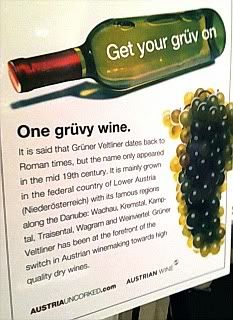 As is the case at wine tasting events where there is a proliferation of one particular type of wine, I experienced palate fatigue and the Gruner Veltliners all started to taste the same. I've experienced the same thing at events that were heavy on Pinot Noir, Tempranillo and Albarino. Mixing it up made for a good palate cleanser. I'd taste whites for a while, then reds, then back to whites. I even went across the property and sampled a few Ribera Tempranillos at another event going on at the same time. As good as those Spanish wines were, I didn't stay long. I couldn't wait to get back to Austria.
As is the case at wine tasting events where there is a proliferation of one particular type of wine, I experienced palate fatigue and the Gruner Veltliners all started to taste the same. I've experienced the same thing at events that were heavy on Pinot Noir, Tempranillo and Albarino. Mixing it up made for a good palate cleanser. I'd taste whites for a while, then reds, then back to whites. I even went across the property and sampled a few Ribera Tempranillos at another event going on at the same time. As good as those Spanish wines were, I didn't stay long. I couldn't wait to get back to Austria.
Austria is roughly at the same latitude as Burgundy, but with more dramatic temperature swings. Hot days and cool nights help produce wines with aromatic, full-bodied character. 35 grape varieties are authorized for use in making quality wine in Austria. About a third of the grapes are red wine, another third Gruner Veltliner. Field blends are common in Austria, where they are called gemischten Satz. These wines are blends in which the different grapes are harvested and vinified at once.
After the event, I retired to the SLS bar to go over my notes. Next to me was a young couple engaged in spirited discussion with Wolfgang Puck. They talked on a number of topics related to food and wine - I couldn't help overhearing - and it wasn't surprising to discover that Puck likes Austrian wines. He has a soft spot for the wines of Alsace as well.
It has occurred to me before - and was brought into sharp focus at Austria Uncorked - that red wines are more about taste while white wines are more about feeling. I'll close with a few of my favorite tastes and feelings of the event.
The event was staged by the Austrian Wine Marketing Board and the Austrian Trade Commission, and event was the featured event for Austria Wine Week LA, in which a handful of tastings were staged around SoCal.
The Wines
 As I mentioned earlier, the wines of Brigit Braunstein and Martin Pasler were my favorites. Their vineyards are in Burgenland, on Lake Neusiedl in the Neusiedlersee - Hugelland region. Braunstein took over her family's winegrowing business in the mid 1990s and produced her first vintage in 1996. She says it was "a moment of real happiness in my life." Her appearance at Austria Uncorked constituted her first visit to the U.S.
As I mentioned earlier, the wines of Brigit Braunstein and Martin Pasler were my favorites. Their vineyards are in Burgenland, on Lake Neusiedl in the Neusiedlersee - Hugelland region. Braunstein took over her family's winegrowing business in the mid 1990s and produced her first vintage in 1996. She says it was "a moment of real happiness in my life." Her appearance at Austria Uncorked constituted her first visit to the U.S.
Braunstein poured two white wines of note, a Welschriesling and a Weissburgunder. Welschriesling has no relation to the Riesling grape and is of unclear origin. Weissburgunder is better known as Pinot Blanc. The former has a lovely, aromatic nose sporting green peppers and flowers, while the latter has a creamy, fruity taste of peaches and pears. Both these whites feature great acidity, but that was not an uncommon tasting note throughout the room.
Braunstein's reds really bowled me over. Her Zweigelt - the most-planted red grape in Austria - has a beautiful cherry nose and a huge cherry taste. The Blaufrankisch shows its chalky, limestone soil with an earthy nose and mineral-laced strawberries on the palate. The St. Laurent - a grape which is a child of Pinot Noir bearing the same cantankerous traits as its parent - is a complete delight. Her Oxhoft red blend marries Blaufrankisch, Zweigelt and Cabernet Sauvignon for a wine which displays enormous red fruit on the nose and on the brilliant palate.
As if these treats were not enough, we proceeded to the dessert wines. A pair of Botrytis-infected beauties were poured. The Beerenauslese blends Welschriesling for acidity, Goldburgerfor the fruit and Neuburger for the sweetness. Sweet pears and apricots show in this delicious dessert wine. The Trockenbeerenauslese is a late harvest Pinot Noir showing the chalky limestone soil in its sultry sugar.
More Wines
Judith Beck - '09 Zweigelt shows extreme earthiness and brilliant fruit flavors at once.
J. Heinrich Winery - '08 Cuvee of Blaufrankisch, Cabernet Sauvignon and Merlot presents a very smokey nose and spicy red fruit.
Juris Winery - '08 St. Laurent has a dirty, funky nose, and I mean that in a great way. Tart and dry, very interesting.
Rosenhof Winery - Four dessert wines - Beerenauslese, two Trockenbeerenauslese and Eiswein - that are sweet with great acidity.
Johanneshof Reinisch Winery - A 2010 Rotgipfler - have you had that grape? - is a white with a nutty salinity and citrus fruit. Also, an $89 '06 St. Laurent which has tannins as smooth as silk.
Salomon Unhof Winery - A 2009 Gruner Veltliner Reserve from the Lindberg Vineyard is creamy and full with a citrus finish.
Turk Winery - A 2009 Gruner Veltliner from the Kremser Sandgrube Vineyard has great acidity and a spicy citrus zest taste.
R & A Pfaffl Wine Estate - A no-oak 2010 Zweigelt with bright cherry nose and flavors would be great chilled on the deck this summer. Their '08 St. Laurent shows fantastic minerals on the nose and a dry, dark cherry taste.
Kracher Winery - They poured six dessert wines. Tops were the '08 Cuvee of Welshriesling and Chardonnay - done in steel, but showing a smokey sweetness - and the '08 ScheurebeTrockenbeerenauslese which is viscous, sweet and clean.
I enjoyed stopping at each table at Austria Uncorked, and limiting myself to just these wines I've mentioned seems an injustice. There were so many great tasting Blaufrankisch, Zeigelt and St. Laurent wines - not to mention all the Gruner Veltliners and Rieslings - that this piece could have gone on for pages and pages. If you are not familiar with Austrian wines, get familiar. You'll be doing yourself and your palate a favor.
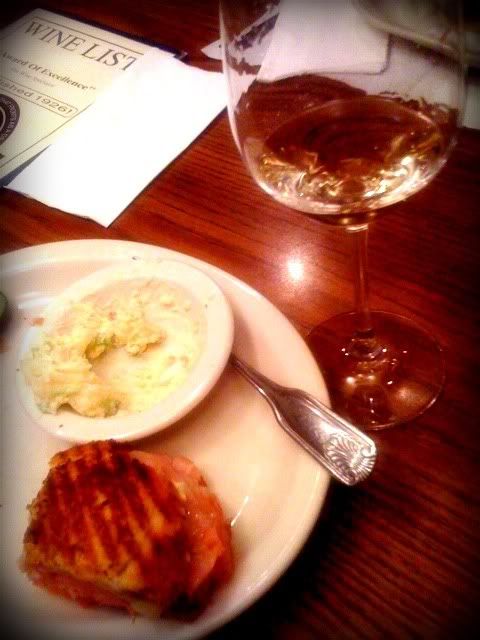
People who stay inside their comfort zones with wine and only drink certain varieties are missing so much. I rarely drink the same brand repeatedly and order offbeat or unusual varieties whenever I have the chance. When I saw a Picpoul by Château Font-Mars on the list at my local deli/wine store, how could I resist?
The appellation of this wine is Coteaux du Languedoc Picpoul de Pinet, from the Languedoc region in the south of France. Picpoul de Pinet is a designation used in the Languedoc for wines made solely with Picpoul Blanc. Font-Mars means "the soil of dinosaurs," and the property took this name due to the fossilized dinosaur eggs which are found there in the limestone and clay soil.
The wine sells for around $10 a bottle online and it cost $8 by the glass at Greenblatt's Deli on Sunset Boulevard in Los Angeles.
The Font-Mars Picpoul is a pretty golden color and smells of minerals and wet straw. The palate shows plenty of wet rocks, green apples and some floral notes and features great, refreshing acidity. A spring day and a mountain stream come to mind. The finish is lovely and long lasting.
The wine would no doubt be fantastic paired with scallops or any sort of seafood, but I had it with a grilled smoked applewood ham sandwich with potato salad, and I was quite satisfied with that pairing. If only there had been a mountain stream nearby.
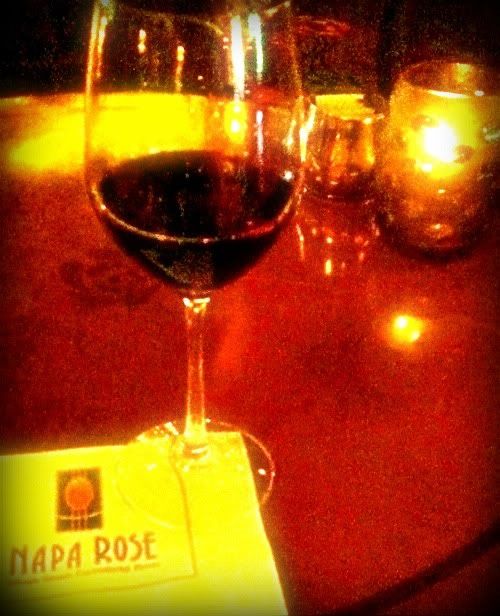
Alexander Hamilton's face on a ten-dollar bill is something we are accustomed to seeing, but on a wine label, not so much. The Federalist Visionary Zinfandel features the founding father's face on the label, presumably as a tip of the three-cornered hat to the guys who helped shape the Constitution of this place we call America.
You'll need two of Hamilton's likenesses on paper money to buy one on the label of this wine, and I had it for $15 by the glass at the always amazing Napa Rose in Disneyland's Grand Californian Hotel.
This Zinfandel is produced from grapes grown on a vineyard in Sonoma County's Dry Creek Valley. The vineyard is owned by the Terlato Family and the vines are new.
Wine
The Federalist Visionary Zin came as a great capper to a day at Disneyland. As usual, we hit Napa Rose a couple of minutes before the 5:00 p.m. opening and took a seat in the lounge.
This single-vineyard Zinfandel shows a big, fruity nose and a bit of alcohol, which blows off in about 15 minutes. The mouthfeel is a little thin for my taste, but the brambly, spicy blackberry flavor carries on for quite a lengthy finish. The effect of the oak is apparent, but not overdone.
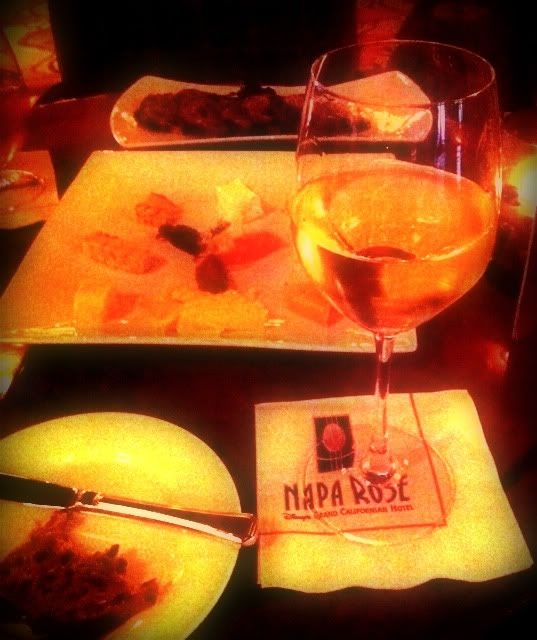 My wife was in the mood to linger for a while, so we ordered a cheese platter and I enjoyed an '08 Beaulieu Vineyards Chardonnay from the Carneros region. A bit of oak appears in this one, but it's nice and balanced in the old California Chardonnay style.
My wife was in the mood to linger for a while, so we ordered a cheese platter and I enjoyed an '08 Beaulieu Vineyards Chardonnay from the Carneros region. A bit of oak appears in this one, but it's nice and balanced in the old California Chardonnay style.
Cheese
That BV Chardonnay paired best with a buttery triple-crème cow's milk cheese from Normandy, Brillat-Savarin. Add a touch of sweetness - the walnut-cranberry bread was fine - and it's quite a mouthful.
Going the other way, the Tête de Moine from the Jara region in Switzerland was my next favorite pairing with the Chardonnay. This "stinky cheese" is also made from cow's milk, and its sharp, nutty flavor played a counterpoint to the creaminess of the wine. It would really "wow" with a late-harvest Viognier, perhaps.
Honorable mention goes to the Garrotxa, a goat's milk cheese from Catalonia, Spain and the Roaring Forties Blue from Australia's King Island Dairy.

Now And Zin is pleased to announce a new series of wine articles in conjunction with TrailersFromHell.com.
The series is called “Blood Of The Vines,” and each Thursday on the Trailers From Hell blog, From Hell It Came, and the Now And Zin Wine Blog, Randy Fuller presents a wine and movie pairing - in tongue-in-cheek fashion.
In case you don’t know about Trailers From Hell, it’s the brainchild of film director Joe Dante. On the site, Joe and other movie “gurus” screen movie trailers and add some personal comments about the films in question. It’s highly entertaining, and highly addictive. Browse the library of titles and see for yourself - betcha can’t watch just one!
Many of the movie gurus are wine lovers as well as film lovers, so this pairing of two different parts of the blogosphere came easily. We hope you find the pairings entertaining, too.
Trailers From Hell began as a haven for horror movie fans, hence the hellish blood references and preponderance of horror movie titles in the trailer library. Over time, the site has broadened to include other types of Hollywood offerings besides the horror genre. It is there, though - in monsters and mayhem - where the roots of Trailers From Hell remain.
Now And Zin has dabbled in mixing wine and movies before - “never mix, never worry” - and we’re starting to get a taste for it. We’d love for you to check out “Blood Of The Vines” on the Now And Zin Wine Blog or the Trailers From Hell blog, From Hell It Came, as wine goes to the movies.
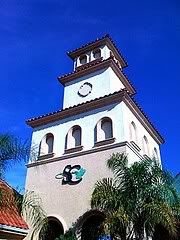
Now And Zin has the pleasure of participating in South Coast Winery's second live-streamed Group Therapy session for 2011.
Wednesday May 25th at 6:00 p.m. PDT, the tasting and fun will get underway in person at the Temecula, California winery or online through Twitter.
Watch online and tweet about the wines as they are tasted. Simply go to WineResort.com and click the Group Therapy button to join the video feed, and use the Twitter hashtag #SCWGroupTherapy to channel your comments into the stream of those participating.
The first time around was a lot of fun, and this venture should be illuminating as well. You can join South Coast Winery on Facebookand follow them on Twitter. The latter is how Now And Zin's Randy Fuller will be participating in the Group Therapy session.
Here are the wines which will be tasted in the Group Therapy session for May:
South Coast Winery Sauvignon Blanc Musqué Clone 2009 Temecula Valley Carter Estate Vineyard
South Coast Winery Brut Temecula Valley Sparkling Wine 2007
South Coast Winery Tempranillo Rosé 2010 Temecula Valley Carter Estate Vineyard
South Coast Winery Syrah 2005 Temecula Valley Rolling Hills Estate Vineyard

The face of the wine industry is changing, according to an article in Wine Enthusiast magazine. The article features comments from Vanessa Robledo, president of Black Coyote Chateau in Napa Valley, a winery which was cofounded by an African-American, Dr. Ernest Bates.
Robledo says Mexican-Americans have always been interested in wine, and as that demographic segment matures and prospers, they are seeking out some of the finer things in life, including wine.
She talks about going to Mexico several years ago and finding that Mexicans were interested not only in wines produced in Mexico, but from all over the world. She feels that Hispanic wine drinkers have had barriers put up for them, notably by restaurants specializing in Mexican food which served only beer and tequila.
One Mexican restaurant in Los Angeles, Loteria Grill, offers Mexican wines now and in Mexico Chef Lugo is helping to put Mexican wine on the same level as beer and tequila in his Mexico City restaurant.
When the Now And Zin Wine Country series kicked off - I'm trying to taste 50 wines from 50 states - Montana was one of the states I feared might not be represented too well. The wine industry in Montana is very small - the winery count was 13 earlier this year - and the weather is just not conducive to growing traditional wine grapes.
An article from Fresh Vino reports that there is work being done in Montana to concentrate on cold weather grapes like Marquette, Frontenac, Traminette and Marechal Foch. They are getting some help from Pat McGlynn, who is the agricultural extension agent at Montana State University. She comes to Montana with experience at Cornell University and New York's Finger Lakes area, so she knows about cold-weather grape growing.
Many climatically-challenged areas make tasty wine from other types of fruit, like cherries, peaches and bluberries. Some take a different approach altogether. Mead.
King Tut drank mead, as did Eric The Red and Queen Elizabeth I. The story goes that someone stumbled upon a beehive that had been out in the rain. The honey inside had fermented, and that was the beginning of mead. Mead is sometimes known as honeywine. Rather than fermenting grapes, or other fruit, it's honey which undergoes fermentation and becomes "nectar of the gods," or "man's oldest drink." Joe Schultz says people were making mead a thousand years before grapes came into play.
Joe Schultz at Hidden Legend Winery makes award-winning mead using Montana honey which is not boiled, thereby avoiding the scorched flavors he says are common in meads. The Hidden Legend mead is all natural, no sulfites are added and Schultz describes his mead as "straddling the fence between dry grape wine and traditional mead." His meads all carry a modest alcohol content of 12.5% abv.
Mead can dry, sweet, still or sparkling. It can also be mixed with fruits or spices for different flavor variations. Hidden Legend Winery makes all kinds of mead. The two varieties they supplied for the Wine Country series are Wild Chokecherry and Spiced Honey Mead.
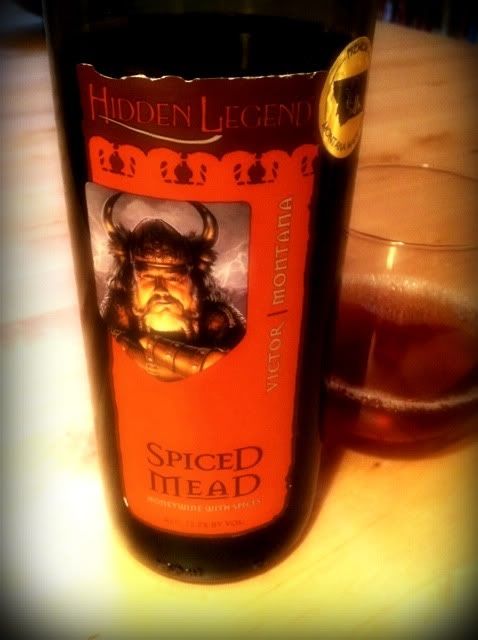 Hidden Legend Spiced MeadLabelled as "honeywine with spices" this beverage carries a suggestion that you "heat it with a stick of cinnamon or serve it over ice with a sprig of mint." It’s a beautiful reddish-brown color, rich, dark and inviting in the glass. The nose is fascinating, with honey dripping from it and spices coloring, but not covering those notes. The aromas remind me first of a Bit-O-Honey candy, then of cinnamon and allspice, and finally a waxy scent wafting up. The honey aromas aren’t really sweet - they are reminiscent of dark honey, like avocado honey or even chestnut honey.
Hidden Legend Spiced MeadLabelled as "honeywine with spices" this beverage carries a suggestion that you "heat it with a stick of cinnamon or serve it over ice with a sprig of mint." It’s a beautiful reddish-brown color, rich, dark and inviting in the glass. The nose is fascinating, with honey dripping from it and spices coloring, but not covering those notes. The aromas remind me first of a Bit-O-Honey candy, then of cinnamon and allspice, and finally a waxy scent wafting up. The honey aromas aren’t really sweet - they are reminiscent of dark honey, like avocado honey or even chestnut honey.
On the palate, the flavor of the honey comes forward first, without the sweetness. This is an off-dry honeywine with a good level of acidity and nice flavors of the spice rack which make themselves known, but don’t take over in a "holiday beverage" sort of way. This is really tasty!
 Hidden Legend Wild Chokecherry Mead
Hidden Legend Wild Chokecherry Mead
This mead is made from 60% honey mead and 40% chokecherry wine. I’ve never been to Montana, so I was unfamiliar with that fruit. It sounds like a cousin to Frankenberry, the made-up breakfast cereal fruit from childhood.
According to Schultz, the chokecherry is a wild cherry which grows throughout Montana and does not turn sweet until after a frost. Schultz says Montanans have been using chokecherries to make syrup and jam for years. He thought it would be nice to blend some chokecherry wine with his honey mead.
Its color is even redder than the Spiced Mead - a translucent cherry-red. There’s a little more of an herbal aroma on the nose, but the honey is still fully present and a layer of cherries joins in to form a truly beautiful bouquet.
The wine tastes much drier than the spiced version. The palate shows a blast of cherry Starburst candy, but in a completely dry framework. Great acidity leaves my mouth watering. I can’t help but think this chokecherry mead would pair very well with a chicken breast or pork chop.
When tasting a wine, I look mainly for four things: color, aroma, taste and acidity. The Wild Chokecherry Mead scores well on all four points. An amazing red color is joined by an intense nose and flavor package, all highlighted by a wonderful feeling of acidity in the mouth. This mead was truly a surprise for me, and it was a delight to drink.
The Hidden Legend Wild Chokecherry Mead won a gold medal in the Tasters Guild International Wine Judging, and after tasting it, I don’t wonder why.

Pairing wine with certain kinds of food can be a difficult matter for some diners. There are certain cuisines which, for my palate, are generally better suited for beer than wine. Indian food calls for a light lager; for Mexican food, give me a Negro Modelo.
Wine Enthusiast ran a brief interview with Chef Gerardo Vázquez Lugo in which he spoke about pairing wine with Mexican food.
Lugo's Restaurante Nicos in Mexico City features an all-Mexican wine list, with the exception of one French wine - and that one is produced by a Mexican winemaker.
The magazine calls his efforts nothing short of heroic in a nation where even the locals look askance at Mexican wines.
Lugo says he doesn't think the pairing process for wine and Mexican food is too different from other cuisines. He likes a barrel-aged Chardonnay with cheese and cream, Syrah with dried chili sauces and Barbera with mushroom quesadillas. He does admit, though, that pairing wine with Mexican food is still rather a novelty, due to the tradition of pairing that country's food with beer.
One of Chef Lugo's favorite pairings is a mole Poblano or Oaxacan black mole with sparkling wine. He says the Ensenada favorite, Lobster Puerto Nuevo - in which the crustacean is fried - is perfect for Chardonnay.
As far as tequila goes - the chef likes it before or after, not with, a meal.
Lugo is a fan of Mexican artisanal beers, but he feels the custom of drinking beer with Mexican food is more a matter of price and marketing efforts than preferential choice.
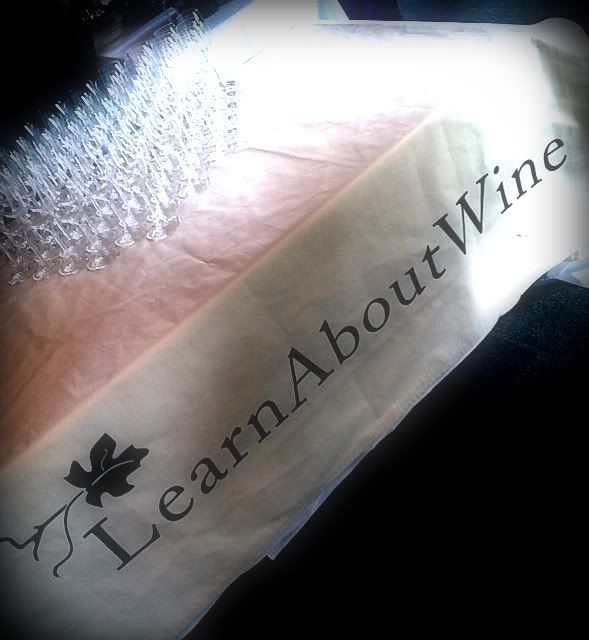
When Paso Robles shows up to pour wine, count me in. The Stars Of Paso Robles event - staged by Southern California's premier wine event outfit, Ian Blackburn's Learn About Wine - featured one great taste after another. I attended the Beverly Hills trade event at McCormick & Schmick's on the afternoon of May 13, 2011. Friday the 13th was never so good.
A roomful of Paso Robles wines meant a roomful of big aromas, big flavors, great acidity and meaty minerals to taste. It also meant a roomful of high alcohol, but that's how it goes in Paso. Every vintage seems to be described as a "spike year."
As I made my way from table to table, it was amazing how many superlative wines were poured. There were plenty of great reds on hand, but in Paso they know how to do whites, too. Every table offered at least two wines which were worthy of mention. I narrowed it down to just those I marked with stars, in the interest of keeping this post from getting out of hand.
Here are my favorites from the Stars Of Paso Robles event:
Adelaida Cellars showed their 2009 Pavanne, a blend of Roussanne, Grenache Blanc and Viognier with great acidity, green apples and minerals.
Alta Colina's Maggie Tillman poured her family's efforts. The reds showed big tannins as a rule, and they rocked. I was most taken with the 2009 12 O'Clock High, a white blend of estate-grown Viognier, Roussanne, Marsanne and Grenache Blanc. Stone fruit and tropical notes are met with honey and minerals and a racy acidity that plays big on the finish.
Bianchi Winery showed a Zinfandel which is lightly tinted and highly expressive on the nose with big black tea aromas and a nice brambly taste. It has an alcohol level of 15.4%, but it doesn't drink like it.
 Cass Vineyard and Winery had a table full of great wines to pour, but partner Ted Plemons was fixated on the big box of Flying Nymph Syrah/Mourvèdre/Grenache which he says is becoming very popular with bars and restaurants due to the high profit margin it offers. That's an 18-liter box inside the display cabinet he had made for it. The fruity wine is tasty, but I liked everything else on the table better.
Cass Vineyard and Winery had a table full of great wines to pour, but partner Ted Plemons was fixated on the big box of Flying Nymph Syrah/Mourvèdre/Grenache which he says is becoming very popular with bars and restaurants due to the high profit margin it offers. That's an 18-liter box inside the display cabinet he had made for it. The fruity wine is tasty, but I liked everything else on the table better.
The Cinquain Cellars table was highlighted by the '07 Syrah which won a gold medal at the San Francisco International Wine Competition a couple of years ago. Coffee and Coke on the nose with spicy dark fruit on the palate bowled me over.
Dubost Ranch winemaker and vineyard manager Zachary Raines had an astounding '07 Zinfandel from the Cushman Vineyard. 40-year-old vines are dry-farmed and tobacco shows up on the nose right through to the amazing port-like finish. When I raised an eyebrow at the 17.2% alcohol number, I was told with a shrug, "It was a hot year." It's still a hot year.
Hammersky Vineyards had some interesting offerings, notably the Cab/Merlot blend with firm tannins and smooth mouthfeel. Table spokesman Brandon described it as the wine "for filet mignon, not T-bone." Their 100% Merlot was a big blast of fruit and smoke.
Joel Peterson of Hope Family Wines poured both his Austin Hope line as well as the Treana label. The Austin Hope Grenache - tons of minerality - and Treana White blend of Marsanne and Viognier - huge tropical - were both excellent. I was really drawn to the new Westside Red Troublemaker, a multi-year vintage with a dark, funky nose and palate and gigantic minerals - all for $20.
JK Wine Company winemaker Justin Kahler poured his '09 Katin Viognier. The grapes are from Paso Robles' Templeton Gap and the 100% varietal wine shows tremendous aromas of honeysuckle and a tempting, flinty salinity from the minerals Paso is famous for.
Niner Wine Estates poured one of my favorites at the event - their 2008 Sangiovese. It's a brand new release with an extremely lush nose featuring flowers, cherries and smoke. The palate shows sour cherry and a fabulous minerality. There's 5% Barbera in the mix.
Roxo Port Cellars is one of my favorite tables at events featuring Paso Robles wines. The chocolatey Cabernet Franc Port and the candy-like Cab/Syrah Port both are astounding, but theTraditional blend of Portuguese varieties moved me. Souzau leads the way instead of Touriga Nacional in the '07 vintage.
Villa Creek Cellars poured their '08 Mas de Maha, a blend of Tempranillo, Grenache, Mourvèdre and Carignan. This wine puts the Paso spin on the Spanish grape, with red fruit on the nose and lots of minerals on the palate. There's a nice herbal profile from the whole-cluster fermentation employed.
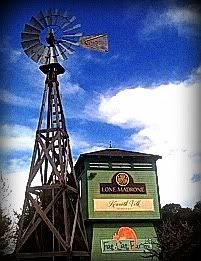
Several years ago at the Ojai Wine Festival I tasted a white blend by Paso Robles producer Lone Madrone that I fell in love with. It's called La Mezcla. The notes of bananas and tropical fruit on the nose, the citrus and minerals on the palate and the zesty acidity made this mix of Grenache Blanc and Albariño an instant favorite of mine.
Lone Madrone's owner and winemaker Neil Collins may be known to you as the Tablas Creek winemaker. Lone Madrone is his personal label.
As long as I was in Paso, I figured I'd better stop in to the tasting room and see what else Collins had to offer.
Lone Madrone's Points West White 2008 has a funky nose and fabulous acidity. A full-feeling wine, it's a blend of Roussanne, Viognier and Picpoul Blanc which displays pears, peaches and a sense of wet rocks on the palate. The '07 Sweet Cheeks is an amazing wine. the grapes are handled in Vin de Paille style, where they are set out on straw in the biodynamic vineyard for a few days after harvest. It has a beautiful, full mouthfeel bursting with apricot nectar.
A dry rosé, the 2010 Zin Blanco is all Zinfandel, showing earthy strawberries for summer. The'09 La Mexcla Roja is great for warm weather, too. It's a bright red wine with a slight effervescence and plenty of earthy minerals. Serve this blend of Grenache, Cinsault, Counoise, Nebbiolo and Zinfandel chilled.
Points West Red 2007 is made of Syrah and Mourvèdre. It has a briar-laced strawberry nose and big red fruit on the palate with a touch of vanilla spice. Barfandel is not a new grape - or a stomach disorder - it's Lone Madrone's blend of Barbera and Zinfandel. White pepper in the bouquet is joined by spicy, brambly red fruit on tha palate.

Numbers from the U.S. Census are cited in a Wine Enthusiast article which shows how Americans are spending their wine dollars.
The numbers say the American public spends $36.3 billion dollars a year on alcoholic beverages.
Women buy more than half of the wine for American households. It's a trend that is gaining momentum over the past few years, particularly in the white, Asian and African-American demographics.
Wine Enthusiast notes that Baby Boomers are being squeezed by other societal segments. Wineries appealing to a Spanish-speaking audience are advertising on Telemundo, while African-Americans are being courted on BET. Millennials are also the target of more advertising dollars.
The magazine says childless singles and single parents are now the second largest wine-buying category, even though single parents tend to earn and spend less. WE figures this will lead to more coverage about the health aspects of wine and more stories on how to stretch the wine dollar farther.
Restaurants are still struggling with recession woes and are looking to wines by the glass rather by the bottle, to help boost revenues, according to the article.

The Now And Zin Wine Country series continues with the wine of Massachusetts. The wine industry in The Bay State is still in its infancy by modern standards, although wine has been produced in Massachusetts since the 1600s. The Pilgrims had barely gotten off the Mayflower when they started making wine from indigenous grapes.
Massachusetts now has over 30 wineries producing over 160,000 gallons of wine per year. Most of the wineries are in the southern portion of the state.
Cape Cod Winery was founded in 1994 by the Lazzari family. The winery is located in the Southeasten New England AVA. In the sandy, gravelly soil of their gently sloping vineyards in East Falmouth, Massachusetts, the Lazzaris grow Cabernet Sauvignon, Cabernet Franc, Merlot and Pinot Grigio grapes. They also grow Seyval and Vidal, and the wine I tasted is a blend of those two white grapes.
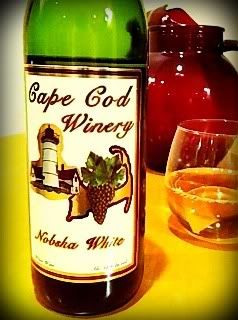 Cape Cod Winery's Nobska White blends Seyval Blanc and Vidal Blanc to produce a semi-sweet white wine with only 12% alcohol content. Both are hybrid grapes, with Seyval ripening early and well suited to cold weather and Vidal noted for its elevated sugar content and high acidity.
Cape Cod Winery's Nobska White blends Seyval Blanc and Vidal Blanc to produce a semi-sweet white wine with only 12% alcohol content. Both are hybrid grapes, with Seyval ripening early and well suited to cold weather and Vidal noted for its elevated sugar content and high acidity.
Nobska White has a beautiful golden color in the glass and is quite aromatic, with a candy-like aroma of guava-meets-cognac. A honey component joins a green pepper scent on the nose as well. The flavor is strongly tropical and finishes like a lemon-lime Sweet Tart. The wine is well suited for pairing with seafood with an acidity level that, while not razor sharp, is crisp and refreshing. The mouthfeel is rather full - it feels almost creamy in the mouth - and should be served chilled for best effect.
I would imagine Cape Cod Winery's Nobska White would be a perfect wine to sip on the deck during warm summertime weather.
Cape Cod Winery also makes two red blends - one of Cabernet Sauvignon and Cabernet Franc and the other a Merlot/Cabernet Franc mix. The winery's blush is created using their Seyval grapes and organic Cape Cod cranberries.
Follow Randy Fuller on Twitter

Paso Robles wine country takes center stage on the sixth episode of the PBS television series Vine Talk, hosted by Stanley Tucci. The series puts Tucci and a panel of celebrities in a loosely formatted setting to taste and talk about wine. It's designed to be an alternative to stuffy wine discussion - the studio audience even gets into the act.
Each week, the series spotlights a different wine region, with a blind tasting and lively banter ensuing. Vine Talk's producers were assisted by the Paso Robles Wine Country Alliance in putting together a sampling of Zinfandels from the region. Episode 106 ofVine Talk features Tucci, FOOD & WINE executive wine editor Ray Isle, celebrity chef Tim Love, former MLB All-Star pitcher Ron Darling and violinist Philippe Quint discussing the Paso Robles Zins they're sampling.
The six wines in question are from Carina Cellars, J Dusi Wines, Peachy Canyon Winery, Steinbeck Vineyards and Winery, Turley Wine Cellars and Victor Hugo Winery.
For more information on Vine Talk, including stations, airtimes and videos from the show, visit the show's website.
"It’s exciting for Paso Robles wines to be highlighted in this show with such incredible personalities," said Christopher Taranto, marketing director of the Paso Robles Wine Country Alliance. "Vine Talk stands to enthrall new wine consumers into discovering Paso Robles and our wines. The timing could not be better as we prepare to celebrate the biggest festival of the year in Paso Robles Wine Country. "
The publicity does come at a great time for Paso Robles, as the 29th Annual Paso Robles Wine Festival is coming May 20 - 22, 2011. The spectacular promises several big events as well as activities at more than 140 Paso wineries throughout the weekend.

If you have yet to check out the website DrinkLocalWine.com, you really should surf by and take a look. The site aims to shed light on the wines of regions other than California, Oregon, Washington. Most wines produced in America come from those three states, but wine is produced in all 50 states, so why not explore the wine produced where you live? Food lovers are doing it with the locavore movement. Why not local wine?
Drink Local Wine is the brainchild of Washington Post wine columnist Dave McIntyre and journalist Jeff Siegel. Their site was featured in an article in WineBusiness.com.
The site has partnered with Texas, Virginia and Missouri on major events promoting the wines in those states and they have another regional conference planned in Colorado.
Now And Zin's Wine Country series is currently attempting to explore wines from all over America, on a somewhat smaller scale.
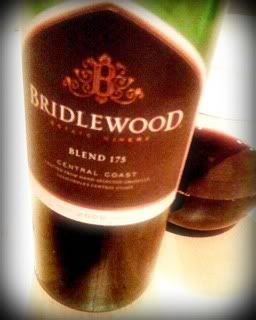
The Bridlewood winery is on the east side of the Santa Ynez Valley, about 30 miles north of Santa Barbara. It’s a white, Mission-style structure with a red tile roof - the kind so popular back down Highway 154 in the Mission city. Bridlewood's winemaker, David Hopkins, has 20 vintages behind him and he works for E & J Gallo, who own Bridlewood The label of Blend 175 states that the wine was bottled at their winery in Healdsburg.
Blend 175 sets a modest alcohol number - just 13% - and I bought it at a grocery store in Los Angeles for $15.
Blend 175 is made up of Syrah, Cabernet Sauvignon and Zinfandel. The winemaking crew tasted through blend after blend after blend, and the 175th blend was the winner. Whether that’s true or apocryphal, I don’t know. It makes a nice paragraph on the label, though.
The wine’s color is medium-dark ruby with some purpling around the edge. Hopkins likes to "follow the fruit," and he certainly does so here. The nose shows a truckload of fruit - blackberry and blueberry - in a straightforward attack on the olfactory. There’s a bit of alcohol upon opening the bottle, and that shows up on the palate as well. I thought that was a bit odd considering the wine carries a reasonable alcohol number.
After it opens up the alcohol burns away and the fruit is gorgeous, dark and lip-smacking with the Syrah showing its spice and the Cabernet letting its graphite speak. Not too much here from the Zin except a very slight hint of brambles coming through. the wine's texture becomes darker on the second and third nights after the bottle was opened.
Film director and wine baron Francis Ford Coppola has undertaken the huge project of trying to breathe life back into the downtrodden Inglenook brand.
A San Francisco Chronicle article in the business section reported that Coppola has acquired the Inglenook name from the Livermore, California-based company The Wine Group. Coppola's Rubicon Estate in Napa Valley is on the actual property which used to be Inglenook. According to the article, he intends to transform the property into America's premier wine estate.
Inglenook enjoyed a three-decade run as one of America's top quality wine producers. That period ended in the mid-1960s when the brand was sold to United Vintners. That started a decline which resulted in the Inglenook label landing in wine's bargain basement alongside Paul Masson, Almaden and Franzia.
Inglenook's current product is looked upon by many as plonk, but Coppola points out that bottles from the company's heyday are still regarded as some of the best Cabernets in the world. His intention is to bring back that kind of quality to the Inglenook name.
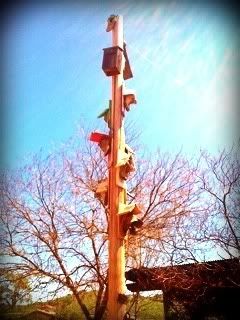
Cass Vineyard and Winery in on the eastside of Paso Robles, in California's Central Coast AVA. They are due east of Templeton Gap, which brings the cool breezes in from the ocean. They do get hot, though, during the day. That's what helps ripen the Rhone grape varieties they grow.
Cass utilizes only estate-grown fruit. The vineyards are all around the tasting room, which I had a chance to visit recently. I didn't go out and literally touch the grapes, but they say you can.
The tasting room is spartan, with a visible, metallic kitchen area where picnic lunches are prepared if you wish to take your meal down a path to an oak-shaded picnic area. There is also seating in the shady front area, near the door of the tasting room. Also just outside the tasting room door is the most unusual birdhouse in the Central Coast (pictured).When Cass says they grow Rhone varietals, they really mean it. From their website:
"A unique feature of our wine making is that all of the Rhone grapes we grow are ENTAV certified. ENTAV (Establissement National Technique pour l’Amelioration de la Viticulture) is the national agency of France responsible for the quality of wine grape varieities. Over 90% of all French Vineyards are started with ENTAV certified plants and are only recently available in California. Consequently, these are among the very first wines made from ENTAV grapes grown here."
It was busy in the tasting room for my visit, with everyone wearing several different hats to accomplish different jobs at once. Here are the wines of Cass winemaker Lood Kotze which were poured for me that day:
Viognier 2009 - All stainless steel, the Viognier is produced using a South African yeast. A somewhat tart nose makes the creaminess in the mouth a bit of a surprise. Nice acidity is doubled on the citrus finish. They tell me the 2010 vintage should have an even rounder mouthfeel.
Roussanne 2009 - Fermented in stainless, this wine is mineral-driven on the nose and palate. Pears and citrus finish with a nutty aftertaste.
Oasis Rosé 2009 - Grenache and Syrah make up most of this blend, but nine varieties in all are used. A touch off-dry, it's got beautiful red fruit from front to finish.
Rockin' One Red 2008 - Syrah, Mourvèdre, Grenache and Petite Sirah make up this heritage wine for Cass - "the one that started it all!" It has a great nose full of red fruit and herbs with a touch of eucalyptus in the flavor profile. It's my favorite from their menu.
Cabernet Sauvignon 2008 - Rich and ripe, this Cab shows silky smooth cassis flavors with a bit of graphite.
A couple of new additions were poured: the '09 Mourvèdre has a nose of chocolate-covered cherry - it's a customer favorite - and the '09 Grenache has a bright cherry nose, wonderful acidity and stirring minerality.
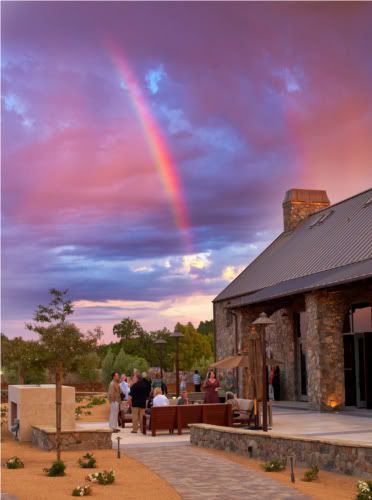
The wine industry boasts many people and companies who would like to make the world a better place. Making great wine for our enjoyment certainly helps in that effort, but there is much more to improving our situation on the planet than knowing how to create a good time in a bottle.
Niner Wine Estates in Paso Robles has gone above and beyond the call of wine, at least according to the U.S. Green Building Council. Niner's state-of-the-art facility has been honored with the organization's LEED Silver Certification. This makes Niner one of only four wineries in California - and the first in the Central Coast AVA - to be recognized in this manner for designing and operating their facility with extreme greenness in mind.
LEED stands for Leadership in Energy and Environmental Design. It's a building rating program, a nationally accepted benchmark for evaluating the design, construction and operation of high performance green buildings. Buildings are certified based on superior performance in energy efficiency, sustainable site development, water efficiency, selection of materials and indoor environmental quality.
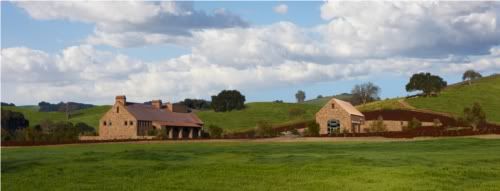 Niner was awarded the LEED Silver Certification for its Paso Robles complex, which includes a Hospitality Center, Demonstration Winery and Production Winery totalling about 75,000 square feet on 140 acres of Westside real estate.
Niner was awarded the LEED Silver Certification for its Paso Robles complex, which includes a Hospitality Center, Demonstration Winery and Production Winery totalling about 75,000 square feet on 140 acres of Westside real estate.
Niner's owners Richard and Pam Niner were over the moon about the certification. According to Rick Fedrizzi, President, CEO and Founding Chair of the U.S. Green Building Council, so was the council. "The work of innovative building projects such as Niner Wine Estates is a fundamental driving force in (the green building) movement," said Fedrizzi.
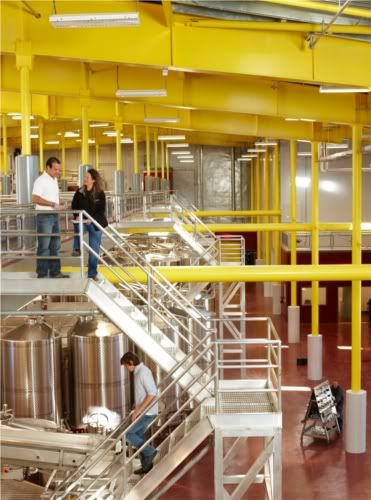 A tour of the facility showed the different facets which allowed Niner to achieve the honor. Niner's enologist, Lorna Kreutz, guided me through the entire Production Winery. She took it all in stride, but I was agog at the pristine conditions I found in the tank room. I guessed that since the place is fairly new, it just hadn't had time to take on a "lived-in" look. "No," said Lorna, "we work pretty hard to keep it looking nice." I spied what looked like a couple of scraps of paper on the floor, but I was wrong again. "Those are actually pieces of tape placed there for measurement purposes," she said. "When the crew is done working, they'll take those up."
A tour of the facility showed the different facets which allowed Niner to achieve the honor. Niner's enologist, Lorna Kreutz, guided me through the entire Production Winery. She took it all in stride, but I was agog at the pristine conditions I found in the tank room. I guessed that since the place is fairly new, it just hadn't had time to take on a "lived-in" look. "No," said Lorna, "we work pretty hard to keep it looking nice." I spied what looked like a couple of scraps of paper on the floor, but I was wrong again. "Those are actually pieces of tape placed there for measurement purposes," she said. "When the crew is done working, they'll take those up."
The building, of course, is not only clean - it's green. It's built into a cut in the hillside to help keep it cool naturally. Insulated concrete walls help with that, too. The cellar has a system which brings in night air, and that also helps reduce cooling needs.
Lorna explained that wastewater is treated and recycled for use as vineyard irrigation, and rainwater is also collected for that purpose.
The building materials are either recycled or locally manufactured, the multi-level design allows gravity to do the work of pumps and even the paint and flooring uses materials which enhance not only the indoor environment, but the one outside as well.
Niner Wine Estates has proven that a technologically advanced facility can also be one that fits well into its surroundings and one that keeps the environment at the forefront. All this comes at some cost. As I poked around various places in Paso Robles, I heard the facility and its "$50 million pricetag" talked about with some pride and, I suspect, some jealousy. I'm sure any winemaker would love to have this kind of winery as a workplace. Niner's winemaker Amanda Cramer should get some of the credit for this design, as she had a hand in creating the Niner winery as a functional wonder of the wine world.
Richard Niner is the visionary here, and he's the guy who put his money where his dreams are. His belief that world class wines are the sum total of great people, great vineyards, great tools and great ideas is the driving force behind Niner Wine Estates.

When you’re tasting a wine at home, it’s always great to be able to pair it with food and find out what it works with, or what it doesn’t.
I often don’t have a nice meal in front of me when I’m evaluating wines, so I end up grabbing a handful of almonds, or fishing an olive out of the jar to have some edible reference point.
Apparently, the folks at Wine Spectator like a little snack food with their wine, too. Wine Spectator School and Triscuit have released the Recipes For Wine Lovers iPhone App. The app allows you to select one of 20 wine-friendly Triscuit recipes. The great wheel of snacks spins around and - clink! - down drops a glass containing just the right wine.
According to the app, for Italian salami and cheese on a Triscuit, select a Cabernet. Hot, sweet, bubbly cheddar on a Triscuit calls for Riesling. Bubbly four-cheese tomato on a Triscuit demands nothing less than Pinot Noir. You get the idea.
If any of the snacks strike your fancy, tap on it and a full screen recipe for that treat appears. Of course, it’s usually not much more instruction than, “take the stuff and put it on a Triscuit, then eat it. With wine."
You can find the Triscuit Small Plates app in the iTunes App Store for free. If you have no iPhone, you access the information by website at the same low price.
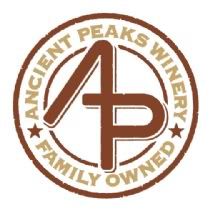
A
trip to Paso Robles, California promised a high level of exposure to people who live and breathe wine. Before my destination arrived, I took the Santa Margarita exit from US Highway 101 and found myself immersed inAncient Peaks Winery.
The Vineyard Tour
It wasn't just a tasting room visit, either. I hopped up into Karl Wittstrom's huge pickup truck and headed for the vineyard, stopping just up the road for a bag of sandwiches to bring along. That's how they do the tour at Ancient Peaks. They get you out of the cozy tasting room and take you where the wine business really happens.
Ancient Peaks is owned as a partnership by three winegrowing families. Karl Wittstrom is one third of that partnership. A towering rancher who knows the vineyards like he knows low gear in that pickup, Wittstrom is a fountain of knowledge about the grapes, the vines, the dirt, the rocks, the mountains, the flora and fauna, the bugs - he knows about everything you can see from any point in his vineyard, and that's a lot. I didn't ask, but I'm sure he could identify every grain of dirt on his dusty floorboard mats.
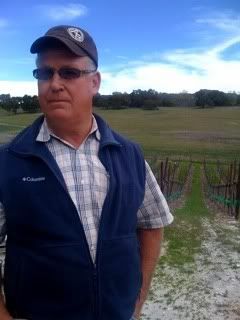 The thing is, you don't have to ask. Karl Wittstrom has all this information ready to spill forth anytime someone looks interested, which I suppose I did.
The thing is, you don't have to ask. Karl Wittstrom has all this information ready to spill forth anytime someone looks interested, which I suppose I did.
His urge to share is so great and his energy so boundless he's the natural choice to guide the tour. At one point he stopped the truck and had me get out to look at a compost station. He turned the mulch with a shovel and stuck his hand in to grab some, so I could see the worms. With boyish enthusiasm he motioned with his head back to the pickup, where my wife was chatting with our companion on the tour. With a complete lack of irony, he asked, "D'ya think she wants to see the worms?" I offered that she could probably skip this lesson, and he continued undaunted, poking the compost with the shovel and explaining how the worms figure into the winegrowing process.
I knew before the tour that there was a lot I didn't know about growing grapes. During the tour, it became increasingly apparent just how much I didn't know.
The People of Ancient Peaks
Wittstrom owns his own family vineyard as well as the partnership vineyards with Ancient Peaks. Doug Filliponi - a longtime local winegrower - oversees all vineyard operations for the winery and Rob Rossi - Ancient Peaks' planning and development guy - is connected in the business side of things.
Mike Sinor - Director of Winemaking - has15 years Central Coast winemaking experience. 2006 was his first full vintage at Ancient Peaks. Amanda Wittstrom-Higgins is the winery's VP of sales and marketing. She's a fifth-generation Paso Robles native.
Growing Grapes
All fruit used by Ancient Peaks comes from their sustainable estate vineyards - SIP certified (Sustainability In Practice) - which allows them to "express the personality of the vineyard."
The different varieties of grapes are allowed to ripen at their own pace.
Vineyard pests are controlled naturally, with a program utilizing boxes as habitats for bats, bluebirds, owls and other predatory birds. No oak trees were removed during the planting of Margarita Vineyard, and wetlands requirements were exceeded.
Margarita Vineyard - sustainably farmed - is the southernmost vineyard in the Paso Robles appellation. It's surrounded by the Santa Lucia mountain range which are the ancient peaks from which the name was taken. It is the only vineyard in the area, and its location in the Santa Margarita Ranch is where grapes were first planted by Franciscan missionaries in 1780.
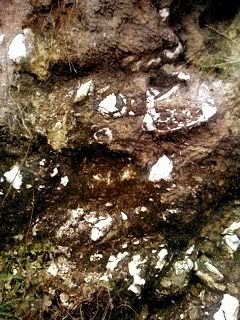 The vineyard features five distinct soil types: ancient sea bed, sedimentary, shale, volcanic and granitic. The folks at Ancient Peaks feel these different soil types bring added dimension and complexity to their wines. Wittstrom delighted in showing off the ancient oyster shells which are imbedded in outcroppings and even scattered about the hillsides of the vineyard.
The vineyard features five distinct soil types: ancient sea bed, sedimentary, shale, volcanic and granitic. The folks at Ancient Peaks feel these different soil types bring added dimension and complexity to their wines. Wittstrom delighted in showing off the ancient oyster shells which are imbedded in outcroppings and even scattered about the hillsides of the vineyard.
Wittstrom concluded the tour by taking us through the rest of the historic Santa Margarita Ranch property dotted with old barns, old things in storage and even an old train built by Walt Disney in 1955. There's history everywhere you look. The train still functions, and they crank it up now and then for special events.
The Wines
Back in the cozy confines of the Ancient Peaks tasting room, we were poured through the wine list. The Ancient Peaks wines are exceptional, each one of them. Most of their wines are in the $14 to $17 price range, with the exception of the Malbec and the Petit Verdot, which sell for $35.
 Sauvignon Blanc 2010 - Grapes from the cool-climate Margarita Vineyard are augmented by a bit of fruit from San Juan Vineyard, in the eastern portion of the Paso Robles AVA. Grass and minerals dominate the expressive nose and the steel-fermented wine is crisp and refreshing with a very nice acidity.
Sauvignon Blanc 2010 - Grapes from the cool-climate Margarita Vineyard are augmented by a bit of fruit from San Juan Vineyard, in the eastern portion of the Paso Robles AVA. Grass and minerals dominate the expressive nose and the steel-fermented wine is crisp and refreshing with a very nice acidity.
Rosé 2010 - Great floral and cherry notes highlight this stainless steel pink made of Pinot Noir from Margarita Vineyard.
Blanco 2010 - Ancient Peaks shows off three of Margarita Vineyard's five soil types in this one.
The Pinot Gris comes from ancient sea bed, the Chardonnay from granitic soil and the Sauvignon Blanc from a sedimentary block. The PG comes on stronger than the Chardonnay, and there's a nice touch of Sauvignon Blanc; minerals galore.
Zinfandel 2008 - Lavendar notes on the nose and a hint of chocolate on the palate make for a delicious experience. The Zin is joined by a splash of Syrah.
Merlot 2009 - This is the variety upon which the brand was founded. Superb minerals play off a cherry/blackberry theme. A bit of help from the Cabs, Sauvignon and Franc.
Cabernet Sauvignon 2009 - Very smooth, and very complex, this Cab has 8% Petit Verdot and 8% Malbec. Cassis and graphite come forward.
Malbec 2008 - One of my favorites here, this wine features a fantastic nose showing traces of violets and chocolate. 8% Syrah.
Petit Verdot 2008 - This 100% varietal wine utilizes grapes from Margarita Vineyard and the warmer climate Wittstrom Vineyard northwest of Paso Robles. It's dark and complicated, with cassis aromas paving the way for a smooth and juicy palate.
Petite Sirah 2008 - The 85% Petite Sirah comes from Karl's personal Wittstrom Vineyard, while 15% is Margarita Vineyard Syrah. A brambly bouquet leads to a dark palate with firm tannins and a caramel finish. This wine carries a 15.7% alcohol number.
Oyster Ridge 2007 - Much of the fruit for this beauty comes from the section of Margarita Vineyard known as Oyster Ridge, the ancient sea bed. Cabernet Sauvignon takes its cues from Petite Sirah, Merlot and Petit Verdot. The nose is big, fruity and floral while the palate shows plenty of minerals. One taste brings the sight of all those oyster fossils into clear focus.




 As is the case at wine tasting events where there is a proliferation of one particular type of wine, I experienced palate fatigue and the Gruner Veltliners all started to taste the same. I've experienced the same thing at events that were heavy on Pinot Noir, Tempranillo and Albarino. Mixing it up made for a good palate cleanser. I'd taste whites for a while, then reds, then back to whites. I even went across the property and sampled a few Ribera Tempranillos at another event going on at the same time. As good as those Spanish wines were, I didn't stay long. I couldn't wait to get back to Austria.
As is the case at wine tasting events where there is a proliferation of one particular type of wine, I experienced palate fatigue and the Gruner Veltliners all started to taste the same. I've experienced the same thing at events that were heavy on Pinot Noir, Tempranillo and Albarino. Mixing it up made for a good palate cleanser. I'd taste whites for a while, then reds, then back to whites. I even went across the property and sampled a few Ribera Tempranillos at another event going on at the same time. As good as those Spanish wines were, I didn't stay long. I couldn't wait to get back to Austria. As I mentioned earlier, the wines of
As I mentioned earlier, the wines of 

 My wife was in the mood to linger for a while, so we ordered a cheese platter and I enjoyed an '08 Beaulieu Vineyards Chardonnay from the Carneros region. A bit of oak appears in this one, but it's nice and balanced in the old California Chardonnay style.
My wife was in the mood to linger for a while, so we ordered a cheese platter and I enjoyed an '08 Beaulieu Vineyards Chardonnay from the Carneros region. A bit of oak appears in this one, but it's nice and balanced in the old California Chardonnay style.



 Hidden Legend Spiced MeadLabelled as "honeywine with spices" this beverage carries a suggestion that you "heat it with a stick of cinnamon or serve it over ice with a sprig of mint." It’s a beautiful reddish-brown color, rich, dark and inviting in the glass. The nose is fascinating, with honey dripping from it and spices coloring, but not covering those notes. The aromas remind me first of a Bit-O-Honey candy, then of cinnamon and allspice, and finally a waxy scent wafting up. The honey aromas aren’t really sweet - they are reminiscent of dark honey, like avocado honey or even chestnut honey.
Hidden Legend Spiced MeadLabelled as "honeywine with spices" this beverage carries a suggestion that you "heat it with a stick of cinnamon or serve it over ice with a sprig of mint." It’s a beautiful reddish-brown color, rich, dark and inviting in the glass. The nose is fascinating, with honey dripping from it and spices coloring, but not covering those notes. The aromas remind me first of a Bit-O-Honey candy, then of cinnamon and allspice, and finally a waxy scent wafting up. The honey aromas aren’t really sweet - they are reminiscent of dark honey, like avocado honey or even chestnut honey. Hidden Legend Wild Chokecherry Mead
Hidden Legend Wild Chokecherry Mead

 Cass Vineyard and Winery had a table full of great wines to pour, but partner Ted Plemons was fixated on the big box of Flying Nymph Syrah/Mourvèdre/Grenache which he says is becoming very popular with bars and restaurants due to the high profit margin it offers. That's an 18-liter box inside the display cabinet he had made for it. The fruity wine is tasty, but I liked everything else on the table better.
Cass Vineyard and Winery had a table full of great wines to pour, but partner Ted Plemons was fixated on the big box of Flying Nymph Syrah/Mourvèdre/Grenache which he says is becoming very popular with bars and restaurants due to the high profit margin it offers. That's an 18-liter box inside the display cabinet he had made for it. The fruity wine is tasty, but I liked everything else on the table better.

 Cape Cod Winery's Nobska White blends Seyval Blanc and Vidal Blanc to produce a semi-sweet white wine with only 12% alcohol content. Both are hybrid grapes, with Seyval ripening early and well suited to cold weather and Vidal noted for its elevated sugar content and high acidity.
Cape Cod Winery's Nobska White blends Seyval Blanc and Vidal Blanc to produce a semi-sweet white wine with only 12% alcohol content. Both are hybrid grapes, with Seyval ripening early and well suited to cold weather and Vidal noted for its elevated sugar content and high acidity.




 Niner was awarded the LEED Silver Certification for its Paso Robles complex, which includes a Hospitality Center, Demonstration Winery and Production Winery totalling about 75,000 square feet on 140 acres of Westside real estate.
Niner was awarded the LEED Silver Certification for its Paso Robles complex, which includes a Hospitality Center, Demonstration Winery and Production Winery totalling about 75,000 square feet on 140 acres of Westside real estate. A tour of the facility showed the different facets which allowed Niner to achieve the honor. Niner's enologist, Lorna Kreutz, guided me through the entire Production Winery. She took it all in stride, but I was agog at the pristine conditions I found in the tank room. I guessed that since the place is fairly new, it just hadn't had time to take on a "lived-in" look. "No," said Lorna, "we work pretty hard to keep it looking nice." I spied what looked like a couple of scraps of paper on the floor, but I was wrong again. "Those are actually pieces of tape placed there for measurement purposes," she said. "When the crew is done working, they'll take those up."
A tour of the facility showed the different facets which allowed Niner to achieve the honor. Niner's enologist, Lorna Kreutz, guided me through the entire Production Winery. She took it all in stride, but I was agog at the pristine conditions I found in the tank room. I guessed that since the place is fairly new, it just hadn't had time to take on a "lived-in" look. "No," said Lorna, "we work pretty hard to keep it looking nice." I spied what looked like a couple of scraps of paper on the floor, but I was wrong again. "Those are actually pieces of tape placed there for measurement purposes," she said. "When the crew is done working, they'll take those up."

 The thing is, you don't have to ask. Karl Wittstrom has all this information ready to spill forth anytime someone looks interested, which I suppose I did.
The thing is, you don't have to ask. Karl Wittstrom has all this information ready to spill forth anytime someone looks interested, which I suppose I did. The vineyard features five distinct soil types: ancient sea bed, sedimentary, shale, volcanic and granitic. The folks at Ancient Peaks feel these different soil types bring added dimension and complexity to their wines. Wittstrom delighted in showing off the ancient oyster shells which are imbedded in outcroppings and even scattered about the hillsides of the vineyard.
The vineyard features five distinct soil types: ancient sea bed, sedimentary, shale, volcanic and granitic. The folks at Ancient Peaks feel these different soil types bring added dimension and complexity to their wines. Wittstrom delighted in showing off the ancient oyster shells which are imbedded in outcroppings and even scattered about the hillsides of the vineyard. Sauvignon Blanc 2010 - Grapes from the cool-climate Margarita Vineyard are augmented by a bit of fruit from San Juan Vineyard, in the eastern portion of the Paso Robles AVA. Grass and minerals dominate the expressive nose and the steel-fermented wine is crisp and refreshing with a very nice acidity.
Sauvignon Blanc 2010 - Grapes from the cool-climate Margarita Vineyard are augmented by a bit of fruit from San Juan Vineyard, in the eastern portion of the Paso Robles AVA. Grass and minerals dominate the expressive nose and the steel-fermented wine is crisp and refreshing with a very nice acidity.